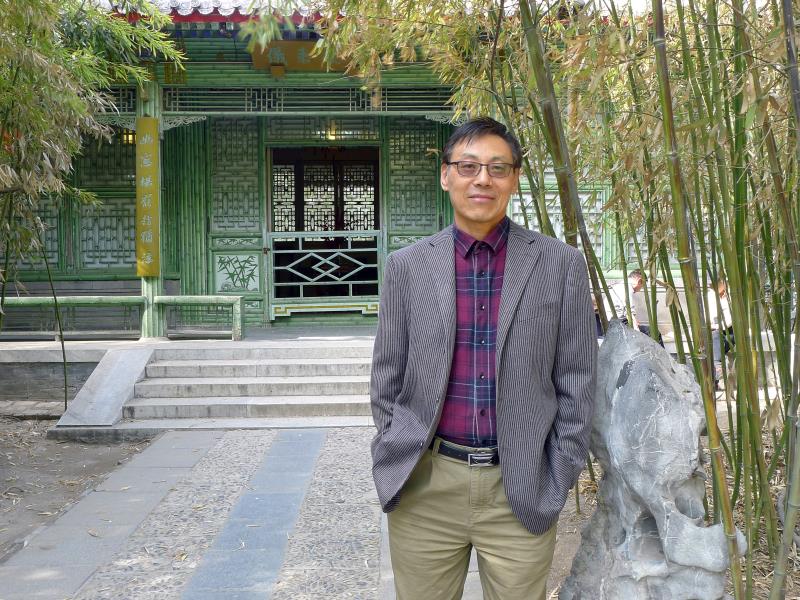
姚恒璐,音乐理论家、作曲家、中央音乐学院作曲系教授、博士生导师。在中央音乐学院作曲系任教期间,先后教授本科、硕士学位的作曲专业课;硕士、博士学位的音乐分析课。开设了作曲技法选修课《20世纪作曲技法分析》、《研讨:现代音乐典型作品中的技法与风格》。长期以来一直坚持音乐创作和理论研究。1994年获英国利兹大学(Leeds University) 作曲专业的第一位哲学博士学位(PhD in composition)。自1990年代以来创作音乐作品百余首(部)、发表各类音乐论文近百篇。
Yao Heng-lu, music theorist, composer,professor and doctoral supervisor in Composition Department at the Central Conservatory of Music, Beijing. During his teaching period in Composition Department at the Central Conservatory of Music, he gave professional lectures in composition courses for undergraduates and postgraduates; music analysis courses for postgraduates and doctoral students. Other selected courses concerning composition techniques include Analysis of Composition Techniques in the 20th Century, Discussion:Techniques and Styles of Typical Works in Modern Music. He devotes himself to composing musical works and researching musical theories. In 1994, he obtained the first PhD degree in composition in Leeds University. Since the 1990s, he has composed more than 100 musical pieces and published nearly 100 music theses of all kinds.
音乐理论研究的多元性展望——风格美感取向下的创作音响认知
MULTIPLE PERSPECTIVE IN RESEARCH OF MUSIC THEORY
Acoustic Identification of Composition under the Choice of Stylistic Aesthetics
【内容提要】
音乐是由音响构成的艺术,首先是通过聆听、理论研究而最终达到审美的目的。理论研究作为对作品客观的分析与审美的重要环节和衔接媒介,一定要确保其观念、方法和实践的统一、严谨,在音响体验中寻求如何符合作曲家本意的诠释音乐作品途径,在尊重创作规律的前提下,择取适当的分析方法,才能得出令人信服的理论结论。
本文围绕着“基于文化与观念的音乐理论研究趋势与发展”这一命题,从4个方面阐述:
一、音高体系化的观念认知——三种音高体系创作分析的实践性;
二、音响体系化的观念认知——作曲技法导致风格美感的变迁;
三、避免新技法作品的风格雷同——风格认同证实了对音响艺术的审美能力;
四、多元文化观念导致多元风格认知与创作途径。
论述从音高和音响体系化这些关乎创作技法的基本要素入手,在具有综合意义的观念认知启发下,指出面对作为聆听的音响艺术,要善于将音响体验归结到理论层面,除了技术分析更要有意识地加强对音乐美感的直接来源: 音乐风格的引证。作曲技法导致音乐风格的变迁,这已经在无数音乐史流派形成发展中得到有力的证实。选材,应当如同创作音乐作品的主题那样重要,也是理论研究最重要的一步。没有风格美感的认定就没有选材能力,更没有对于作品整体结构与局部细节的把握分析能力。
在以作曲技术理论为主体的理论分析研究当中,要关注作品产生的文化背景,文化底蕴决定了作品的深刻程度、文化观念伸张了音乐表现的宽广度;笔者以一些中国文化中的特有理性艺术现象,说明艺术技法来源于观念文化,存在于古已有之的人类生存状态当中。
应当避免以单纯技术观点去诠释一部成功的艺术作品,音乐作品的理论研究是以“观念-意识-技法-风格-审美”作为有机关联的主线,也是创作与分析共同遵守的艺术规律。
Music is an art of sound. It is through a combination of listening and theoretical research that we reach the ultimate goal of aesthetics. Theoretical researches serve as an important stage between the objective analysis and aesthetic appreciation of musical works, which ensures its consistency and rigorousness in conceptions, approaches and practices. By interpreting music according to composer’s intention from listening experience, and then, under the principle in respecting the compositional regulation, selecting appropriate approaches for analysis, we can draw convincing theoretical conclusions.
Themed on “Research Trend and Development on the basis of Culture and Ideology in Music Theory”, this thesis unfolds in four parts:
firstly, concept identification of systematized pitch-system – practicality in three sorts of pitch system for compositional analysis;
secondly, concept identification of systematized sound – changes of stylistic aesthetics due to the difference of compositional technique;
thirdly, avoiding the neo-duplication in using new composing techniques, the aesthetics ability to sound art testified by stylistic identify;
fourthly, multiple cultural conception results multiple stylistic identification and composing procedure
The illustrations focus on the basic factors of compositional techniques, such as systematized sound and systematized pitch-system, and under the inspiration of concept identification of omni-bearing significance, points out that, with regard to the art of sound, it is essential to summarize the sound experience into theories, and stress on stylistic quote which is the direct sources of musical aesthetics consciously. The different compositional techniques result in changes of music styles, which has been proved in the development of multiple music genres. Selecting materials is as important as composing a piece of music, and thus is the most critical stage in theory study. Without an identification of stylistic aesthetics, the researcher cannot be said to be able to select musical materials, nor capable of understanding and analyzing the whole structure and partial details of a composition.
In the analysis and research of composition technique theories, the focus should be on the work’s cultural background, as it is cultural deposits that determine the abundance of artworks’ implications, and cultural values broaden the coverage of musical expression. The author cites some typical rational artistic phenomenon in Chinese culture to illustrate that artistic techniques come from concept culture and exist in the lives of humankind since ancient times.
Furthermore, Yao remarked that the researchers should refrain from interpreting successful artistic works from a single perspective of techniques. Theoretical researches should be conducted according to the organically integrated mainline of “concept – consciousness – techniques – style – aesthetics.” This is also an artistic law which composition and analysis commonly abided by.



